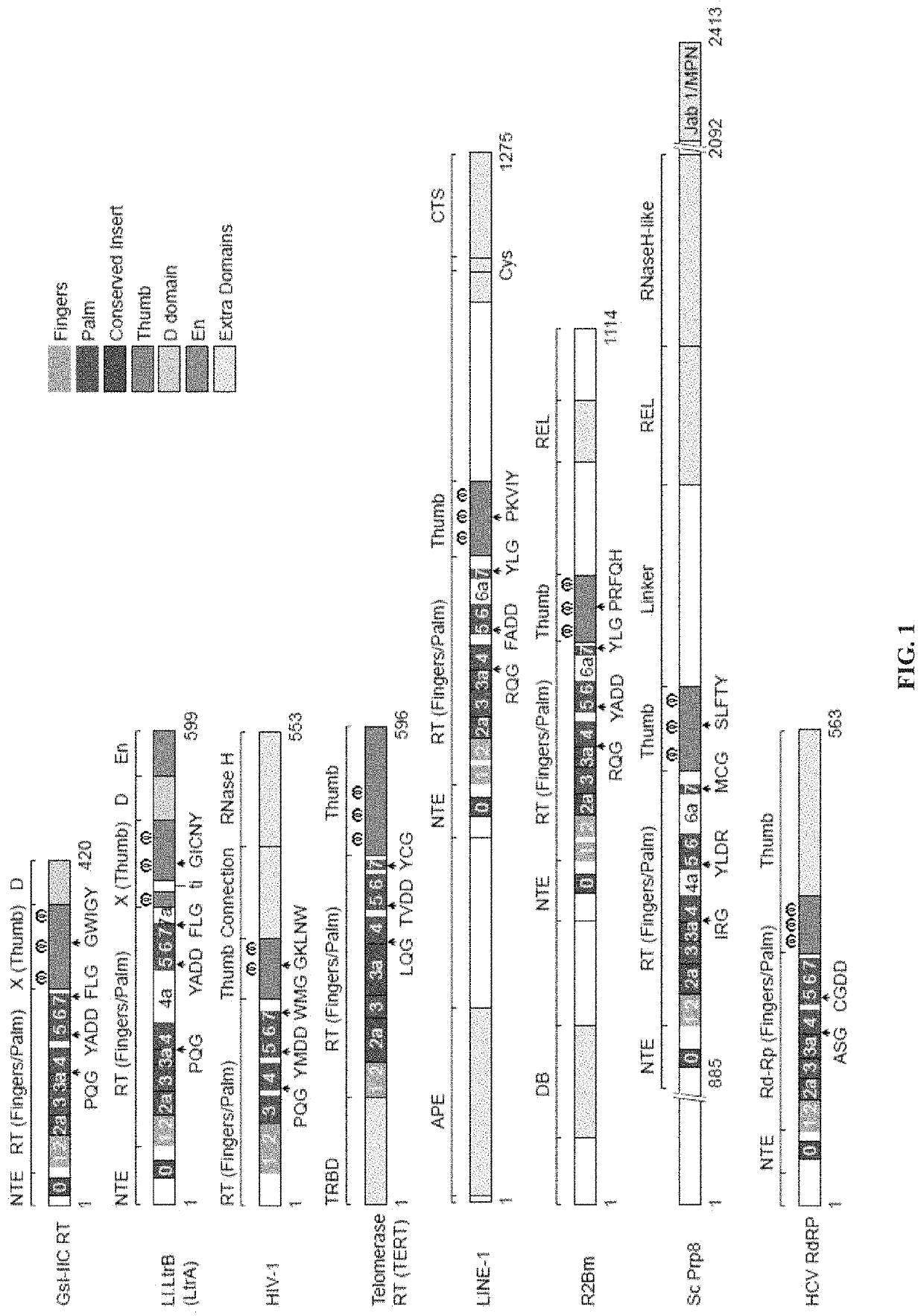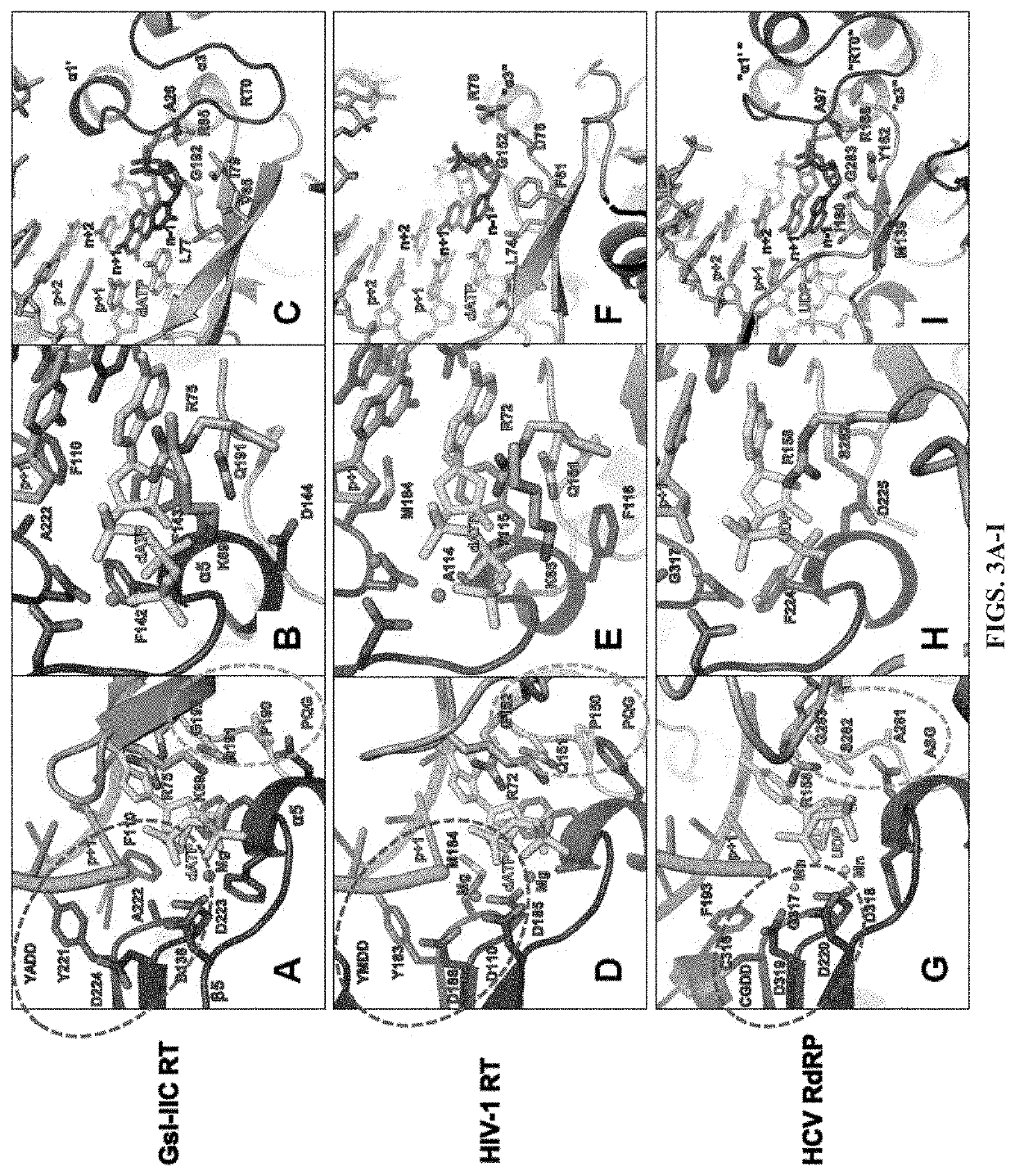Non-LTR-retroelement reverse transcriptase and uses thereof
a reverse transcriptase and retroelement technology, applied in the field ofmolecular biology and biochemistry, can solve the problems of unmet need to elucidate and lack of high-resolution structural information about group ii intron rts
- Summary
- Abstract
- Description
- Claims
- Application Information
AI Technical Summary
Benefits of technology
Problems solved by technology
Method used
Image
Examples
example 1
Thermostable Group II Intron Reverse Transcriptase Characterization
[0057]Comparison of Group II Intron RTs and Related Proteins: FIG. 1 compares the domain structures of two group II intron RTs, GsI-IIC RT analyzed in the present studies and the L1.LtrB RT (LtrA protein) studied previously, with a series of related proteins to which group II intron RTs were compared in this work. These include the retrovirus HIV-1 RT, telomerase RT (TERT), non-LTR-retrotransposon LINE-1 and R2Bm RTs, spliceosomal protein Prp8, and hepatitis C virus (HCV) RdRP. Like retroviral RTs, group II intron RTs have an N-terminal RT domain, which corresponds to the fingers and palm of the canonical right-hand like structure of nucleic acid polymerases and contains seven conserved sequence blocks (RT1-7) present in all RTs. Following the RT domain is a region corresponding to the thumb domain of retroviral RTs (Blocker et al., 2005). This region has been referred to as domain X and sometimes as the maturase dom...
example 2
Methods and Materials
[0082]Constructs: Full length His-tag GsI-IIC RT used for crystallization contained the native N-terminus and was constructed by adding a non-cleavable 8×His tag directly to the C-terminus by PCR from a GsI-IIC RT pMal fusion vector described previously (Mohr et al., 2013). The PCR product was ligated into the pET14b expression vector (Millipore) using NcoI and PstI restriction sites. The vector was transformed into BL21-CodonPlus (DE3)-RIPL chemically competent cells (Agilent) and plated onto LB plates containing 100 μg / mL ampicillin and 25 μg / mL chloramphenicol.
[0083]Wild-type and mutant GsI-IIC RT proteins used in biochemical assays were expressed as maltose-binding protein rigid fusions from pMRF-GsI-IIC (Mohr et al., 2013). GsI-IIC RT mutants were constructed in pMRF-GsI-IIC by site-directed mutagenesis using a Q5 Site Directed Mutagenesis Kit (New England Biolabs) with primers listed in Table S2. Constructs were transformed into Rosetta 2 (DE3) (EMD Millip...
example 3
Further Amino Acid Substitutions Into the RT
[0098]Further studies were undertaken to generate and study additional amino acid substitutions into the surface of the non-LTR-retroelement reverse transcriptase. Details regarding the additional substitutions made are shown in the Table 3 below. Various of the additional substituted RT proteins were further tested to determine effects on protein yield during recombinant expression (FIGS. 13-14, 17) and / or effects on RT activity (FIGS. 15-17).
[0099]GsI-IIC RT mutants were expressed as recombinant proteins in E. coli, and those that could be expressed were purified and tested for RT activity in primer extension assays. All proteins contain an N-terminal solublity tag (MalE protein) fused to the GsI-IIC RT via a non-cleavable linker (Mohr et al., 2013). In general, all proteins expressed similarly to WT, the only exception was the R311L mutant (FIG. 13). In terms of yield we observed that several mutants increased the total yield of purifie...
PUM
| Property | Measurement | Unit |
|---|---|---|
| rotation | aaaaa | aaaaa |
| pH | aaaaa | aaaaa |
| bed volume | aaaaa | aaaaa |
Abstract
Description
Claims
Application Information
 Login to View More
Login to View More - R&D
- Intellectual Property
- Life Sciences
- Materials
- Tech Scout
- Unparalleled Data Quality
- Higher Quality Content
- 60% Fewer Hallucinations
Browse by: Latest US Patents, China's latest patents, Technical Efficacy Thesaurus, Application Domain, Technology Topic, Popular Technical Reports.
© 2025 PatSnap. All rights reserved.Legal|Privacy policy|Modern Slavery Act Transparency Statement|Sitemap|About US| Contact US: help@patsnap.com



